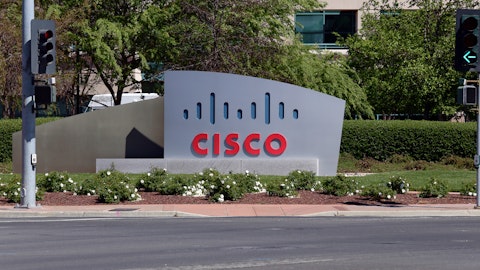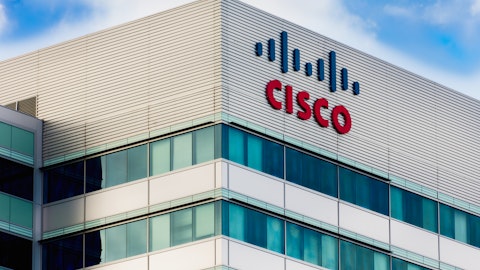Synergy Research reported similar figures and noted that Cisco is about seven times the size of its next largest rival in switching and routing technologies.
Why has Cisco been able to dominate these markets?
Cisco’s advantage starts with its ability to offer customers an entire suite of solutions with its network equipment and services. The company has evolved from selling networking hardware into selling higher-value packages of complete architectures and solutions that improve customers’ businesses.
Selling architectural solutions is much more profitable for Cisco and allows the customer to deal with fewer vendors and potentially enjoy a lower total cost of ownership.
Most of Cisco’s competitors do not have the same breadth of products and services (e.g. security, switching, wireless, routing, collaboration), making them less of a factor in these lucrative deals.
Cisco has spent more than $18 billion on research and development over the last three years combined to stay relevant and build out its portfolio, a magnitude of spending that few companies can come close to matching.
Cisco also has about $2 billion in venture capital investments that help it gain forward-looking insights into the changes its markets are going through.
To continuously round out its portfolio to meet the market’s evolving needs, Cisco has spent more than $80 billion since 1995 to acquire over 250 companies and has also partnered with major technology players such as EMC Corporation (NYSE:EMC), VMware, Inc. (NYSE:VMW), Ericsson (ADR) (NASDAQ:ERIC), and Apple Inc. (NASDAQ:AAPL).
Simply put, it’s very difficult for competitors to match the company’s breadth of products and services.
By focusing on developing extremely reliable hardware, building a brand based on quality, and using its economies of scale to keep costs low ($49 billion revenue base last year), Cisco typically enjoys price premiums and very healthy margins on its products.
Beyond its technology portfolio and unique ability to deliver architectural solutions, Cisco is a sales and marketing juggernaut that has established one of the 15 most valuable brands in the world.
At the end of fiscal year 2015, Cisco’s worldwide sales and marketing departments had approximately 25,000 employees and field sales offices in more than 90 countries.
However, a substantial portion of Cisco’s products and services are sold through channel partners such as telecom providers (e.g. Verizon Communications Inc. (NYSE:VZ) and AT&T Inc. (NYSE:T)) and systems integrators.
Cisco Systems, Inc. (NASDAQ:CSCO) has maintained these relationships for a very long period of time and is uniquely positioned to meet the needs of its biggest partners thanks to its broad portfolio, brand strength, and ability to deliver high volumes of product.
As a result, the company has built up a massive installed base that provides steady revenue opportunities.
Overall, Cisco just does a great job of providing cost-effective, integrated solutions at scale to customers. The company has built a reputation for reliability and is trusted by customers.
Given the perceived similarities between many of the products in Cisco’s markets, its branding and long-lasting channel partner and customer relationships are especially important.
As our readers know, in addition to investing in companies with a clear economic moat, we also prefer to buy businesses that operate in industries characterized by a slow pace of change. After all, change is often the enemy of predictable cash flow generation.
Cisco’s core markets are no doubt characterized by a faster pace of change than other industries such as trash collection or packaged food, but their importance should not be overlooked.
Cisco’s networking products are extremely important for any infrastructure environment and are necessary for virtually any business. Without Cisco, much of the country’s communications infrastructure would literally not function.
As the use of data and bandwidth continues to see exponential growth, more networking infrastructure is also needed, providing a long stream of demand.
There seems to be no end in sight to the number of consumer and business devices needed to be connected to a network. While this certainly doesn’t guarantee Cisco’s future success, we appreciate the mission-critical nature of most of the company’s products and services.




